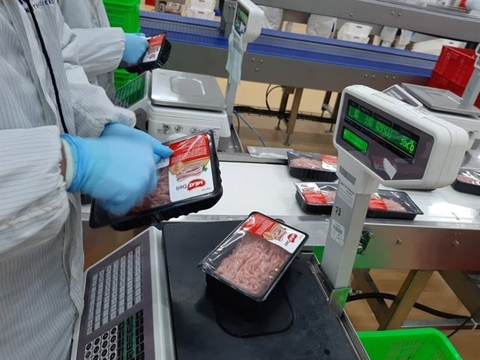 |
|
Meat Deli chilled pork. Viet Nam hopes to promote the processed meat industry.
|
According to the husbandry development strategy for 2021-30 with a vision to 2045 approved by Prime Minister Nguyen Xuan Phuc on Tuesday, all meat must be supplied from centralised slaughterhouses by 2045. More than 70 per cent must be processed, 30 per cent of which must undergo deep processing.
The husbandry industry is hoped to become a modern economic sector industrialised in all stages from production, processing, preservation and distribution.
Viet Nam targets entering the leading group of countries in Southeast Asia in terms of husbandry production capacity.
Attracting investment to the processed meat industry is necessary to improve product quality, added value as well as competitiveness with imported products and promote consumption and export for the domestic husbandry industry.
Early this month, Masan MEATLife Joint Stock Company, a member of Masan Group, launched a VND$1.8 trillion (US$77.5 million) meat processing plant in Tan Duc Industrial Park, Long An Province. The plant has the capacity of processing 1.4 million livestock per year.
In the first stage, the plant can process 140,000 tonnes of fresh chilled pork per year together with 15,000 tonnes of processed meat products such as braised pork, pork rolls and shredded pork.
The second phase will expand capacity to 25,000 tonnes a year and enable the production of 14,000 tonnes of pork by-products such as blood flour, plasma, collagen and meat and bone powder.
Masan two years ago opened a meat processing plant in Dong Van Industrial Park, Ha Nam Province, with the capacity to process 150-300 pigs per day.
Both plants were operated following the British Retail Consortium Global Standard for Food Safety.
This could be seen as an optimistic signal for the meat processing industry of Viet Nam which still has a number of limitations in terms of product quality, food safety and export capacity.
Experts have said that processing could greatly help increase the value of the livestock industry, especially for the $10 billion pork market.
Masan MEATLife expects that branded meat products will contribute about 50 – 70 per cent of its revenue when consumers shift to consuming safe meat products with origin tracing, hygiene and reasonable prices.
According to Vo Trong Thanh from the Ministry of Agriculture and Rural Development’s Animal Husbandry Department, more attention will be attached to slaughtering and meat processing to ensure 25-30 per cent of meat is processed by 2025 and 40-50 per cent by 2030.
The investments of some companies in the meat processing industry remained modest and must be enhanced, he said. — VNS